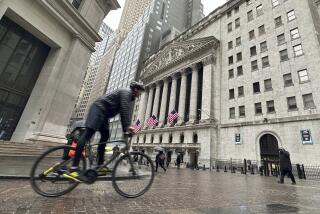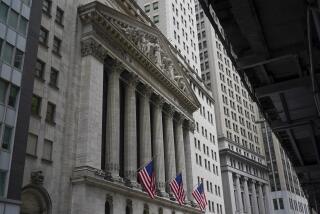Fear fades as stocks rally
NEW YORK — Month after month, Stan Wright watched impatiently as the stock market climbed higher while his money sat on the sidelines earning next to nothing.
Like many Americans, Wright, 51, yanked his savings out stocks during the 2008 financial crisis and pinned his hopes on historically safer investments in bonds. Now he wants back in on the stock market, which is in the midst of its strongest rally in a decade.
“There is really, truly almost no place else to put money right now,” said Wright, a Bay Area business owner who has sunk $10,000 into stocks in the last six weeks. “It’s just a shocking and painful thing to watch while you’re sitting in cash, that’s for sure.”
Newfound enthusiasm among small investors helped power the Dow Jones industrial average to its first close above 16,000 on Thursday.
It was the latest in a series of record highs in what could be labeled the process-of-elimination rally.
The U.S. economy is sluggish, corporate earnings are lukewarm and Washington is convulsed by ceaseless infighting.
But many investors believe they have no alternative to stocks, given the chronically low interest rates on bonds and bank accounts. And as share prices race higher, people worry more about missing gains than suffering losses.
“There’s a lot of catch-up,” said Russ Koesterich, chief investment strategist at financial giant BlackRock Inc. “A lot of investors have been gun-shy about stocks.”
The Dow has surged 23% this year, its best showing since a 25% jump in 2003. The broader Standard & Poor’s 500 index is up 27%, and the tech-heavy Nasdaq has ballooned 32%.
The Wilshire 5000 Total Market Index, the broadest measure of the American stock market, has gained $4.8 trillion this year.
The sharp run-up has surprised even the most bullish Wall Street prognosticators, who have repeatedly torn up their predictions about how the stock market would do this year.
Optimists on Wall Street say the market is in the middle of a multiyear run and that a steadily improving economy will provide fuel to push prices higher in 2014.
That’s the hope of small investors, who have overcome a deep aversion to stocks following stinging losses in the financial crisis.
Individuals have poured nearly $24 billion into U.S. equity mutual funds in the last five weeks. That’s a sharp reversal from the more than $600 billion they had yanked since the beginning of 2007.
The rally is causing investors such as Cary Hart to rethink their reluctance to stocks.
The 53-year-old Florida restaurateur initially thought the stock market had risen too fast and that investors were overestimating the strength of the U.S. recovery. But he began putting about $250,000 into the stock market in August.
“I surrendered to it,” Hart said. “I just said I’m going to get on this train, stay on the train, and if there’s a pull-back, then I’m just going to have to ride it out.”
However, individuals’ sudden ardor has stirred consternation on Wall Street.
Small investors are historically terrible market timers. They typically jump into stocks long after bull markets are underway, setting themselves up for bruising losses when an eventual downturn hits.
The current rally began in March 2009. The Dow has risen 145% since then.
Bears on Wall Street attribute the market rally to the massive stimulus by the Federal Reserve.
By buying $85 billion a month in bonds, the central bank has pushed down long-term interest rates to make borrowing cheaper as a way to boost growth. That has all but forced investors into riskier assets such as stocks.
Stocks, they say, could get hit hard when the Fed eventually tapers those purchases, which is generally expected early next year.
Some data suggest that stocks have gotten pricey. Compared with underlying sales and profits, the S&P; 500 trades above its 10-year average, according to FactSet Research Systems.
One closely watched indicator of investor sentiment doesn’t indicate a blind stampede into stocks. A survey released last week by the American Assn. of Individual Investors found 34.4% of investors identifying as bullish, a decline of about 5 percentage points from the previous week and lower than the long-term average of 39%.
The fundamental driver of stock prices — corporate profits — soared in 2010 and 2011, but growth has been lukewarm in the last two years.
“The stock market is not cheap,” said Barry Knapp, who heads U.S. equity strategy at Barclays in New York. “We do share this concern that the stock market is expensive, and we do think that that will impact returns in 2014. We’re not at all-time extremes, but it’s on the high side.”
The rally has proven powerful enough — so far — to put stocks back in investors’ good graces following two painful bloodbaths in recent memory.
First came the dot-com bust after a frothy stampede into Internet companies in the late ‘90s and early 2000s. Despite steep losses then, at least 60% of Americans reported owning stocks, either directly or through a mutual fund or retirement account, according to a Gallup poll.
Stock ownership by individuals sank in the last five years to 52% in April.
Scott Winzeler, a 53-year-old business consultant near Nashville, kept much of his savings parked in stocks even through the worst of the financial crisis.
But as the Dow neared 16,000, he wanted to skim more than $150,000 in profit off his investment accounts and lock them into historically safe vehicles: Treasury bills, municipal bonds and certificates of deposits.
Winzeler, who grew up in Los Angeles, figures he’s a decade away from retirement and can’t wait for another bull market to come and go.
“It’s not going to keep rising,” he reasoned. “It’s a lot better walking away with something in your pocket.”






